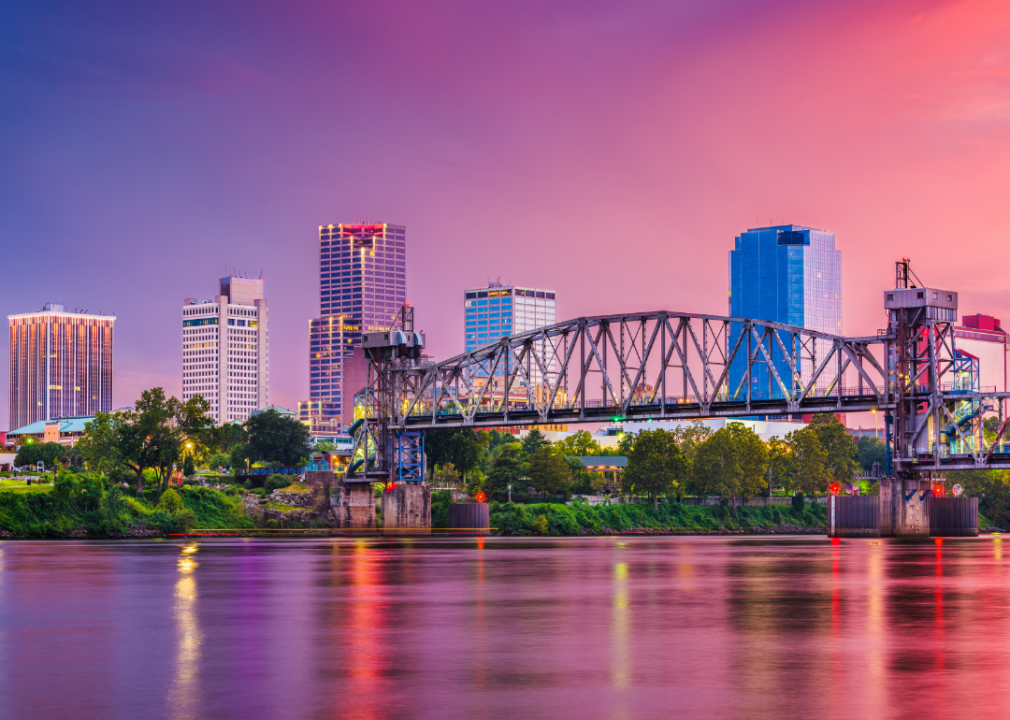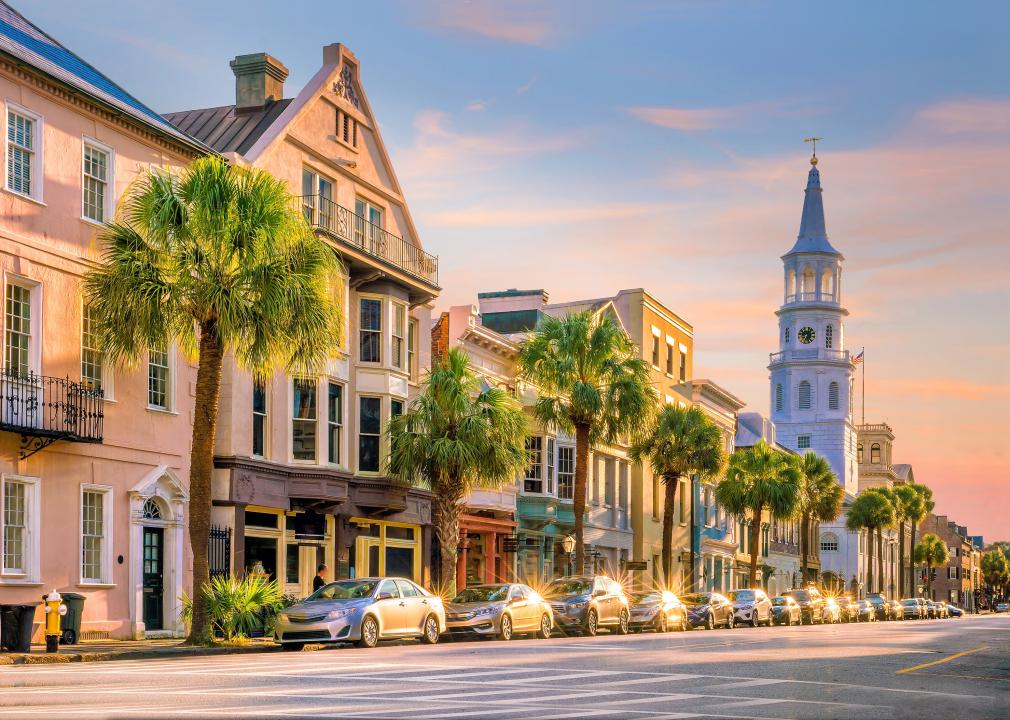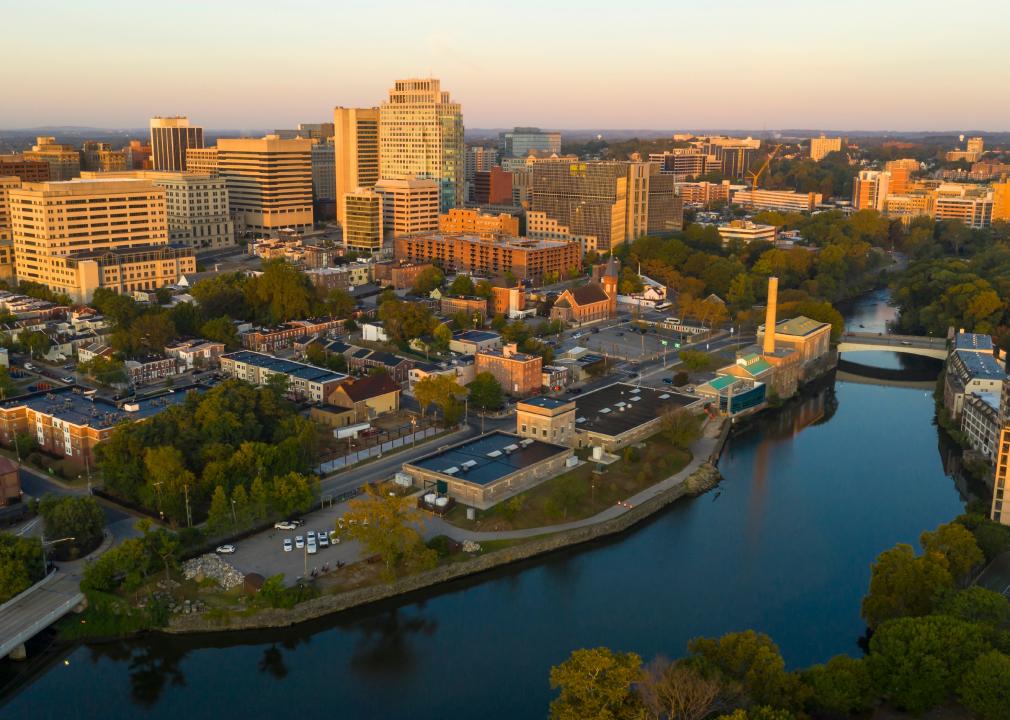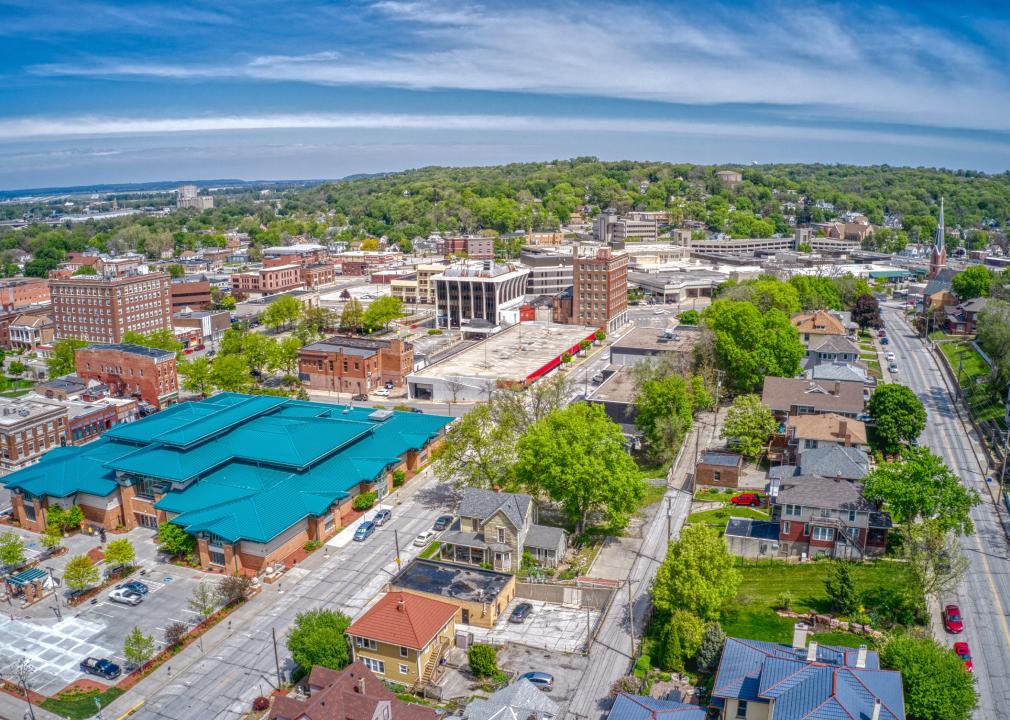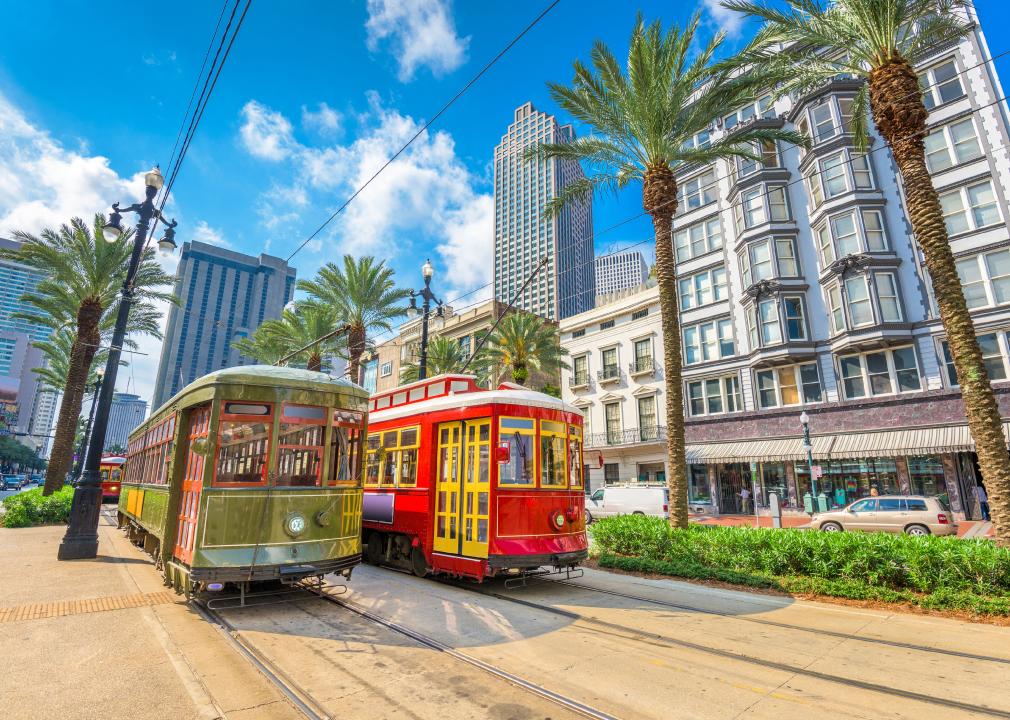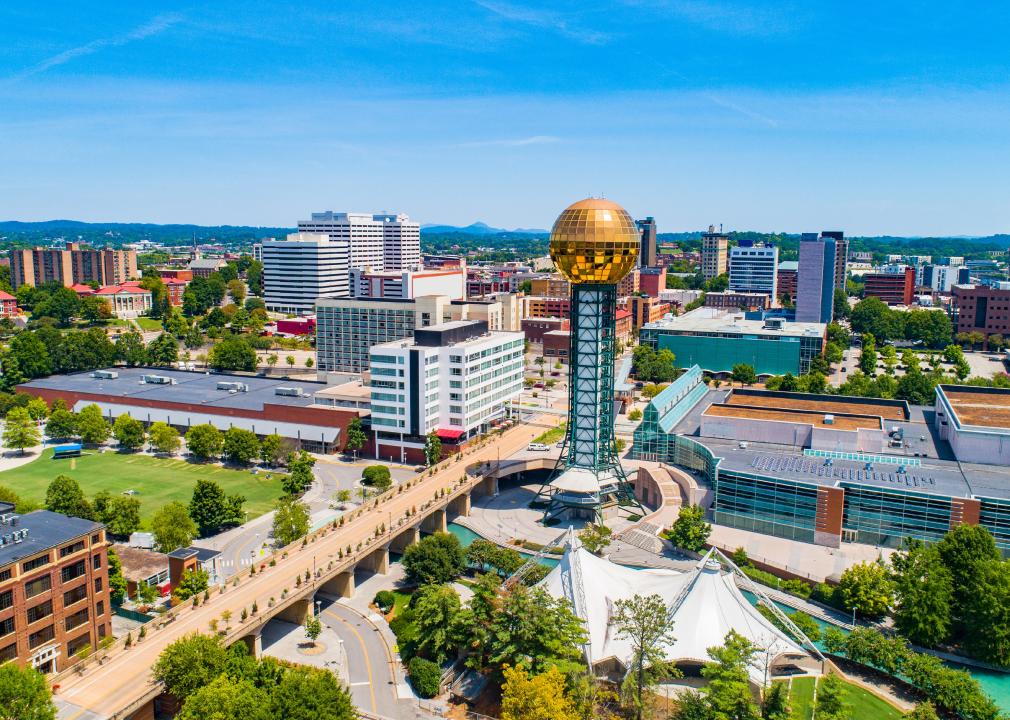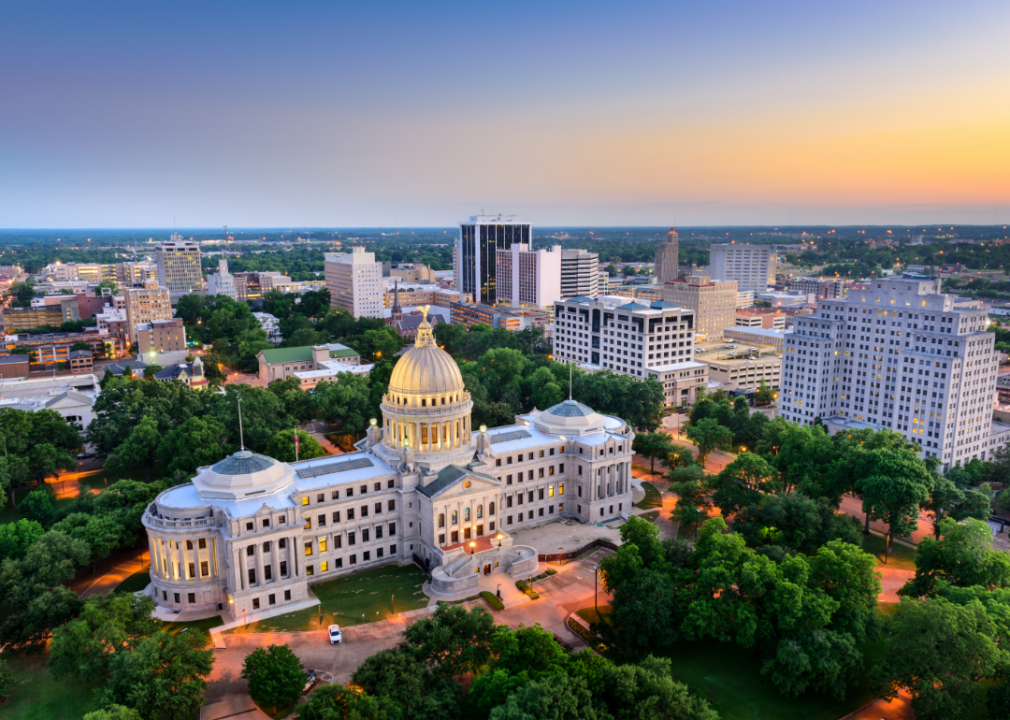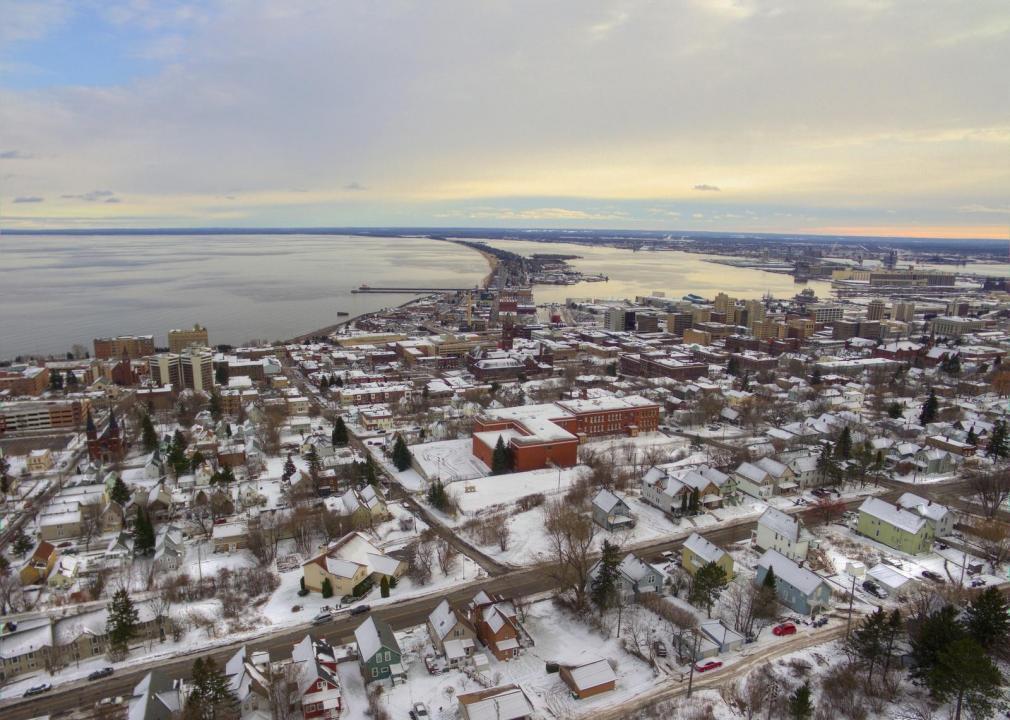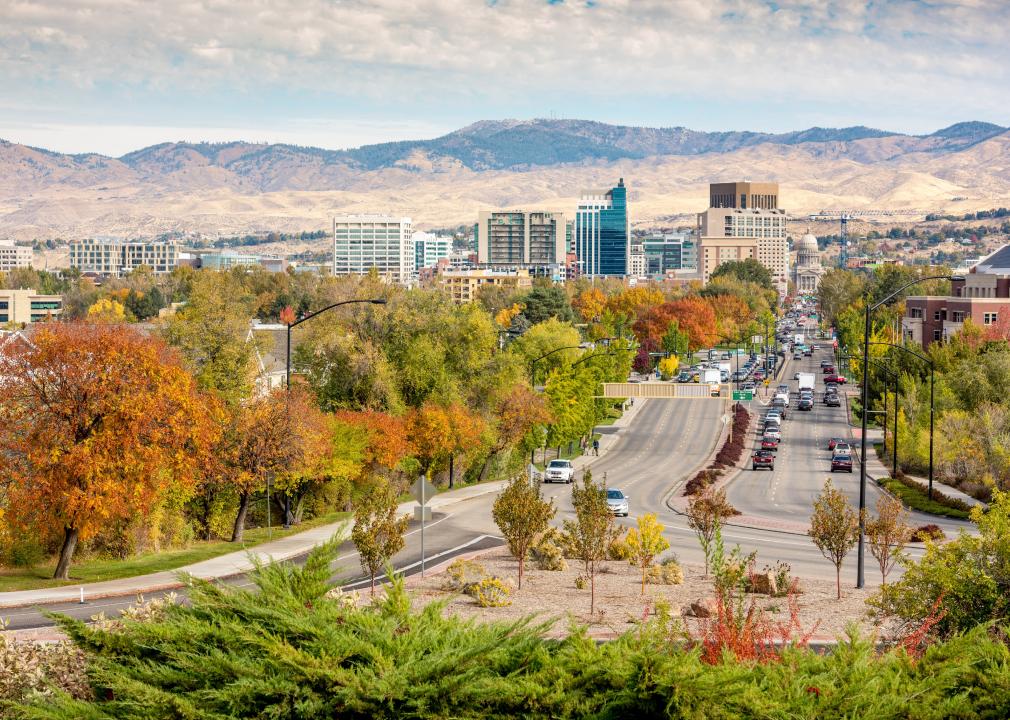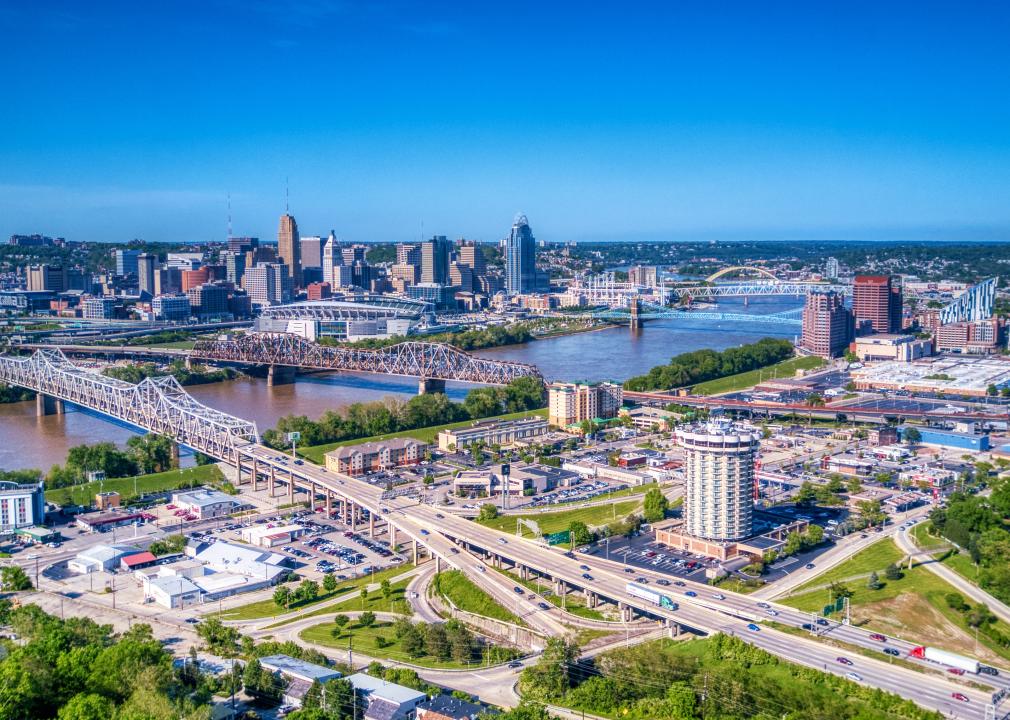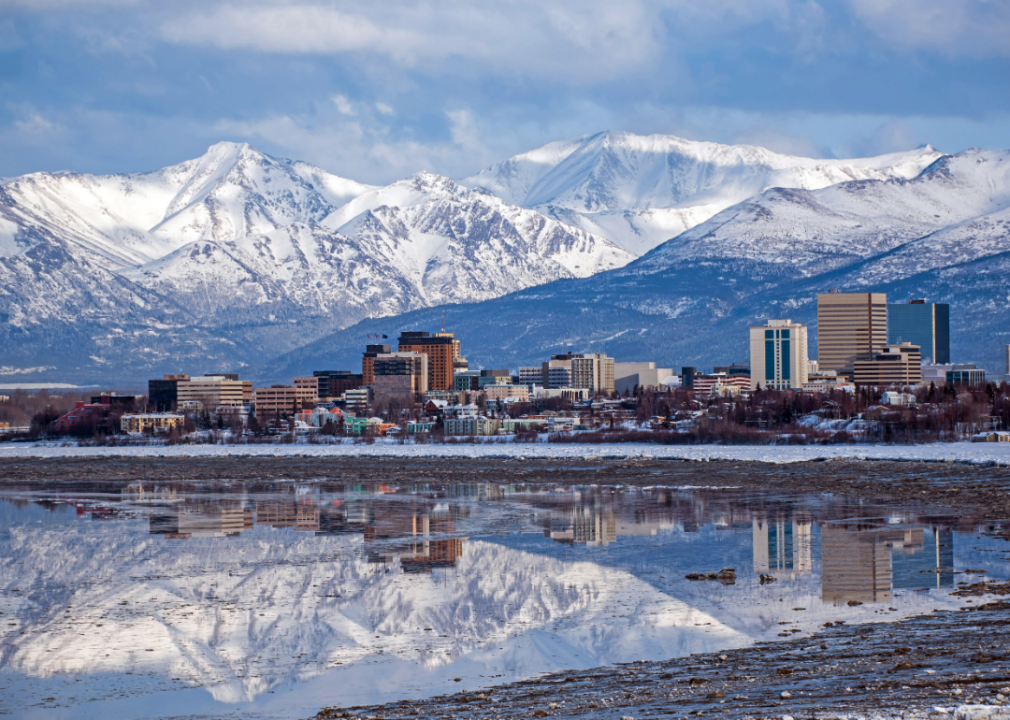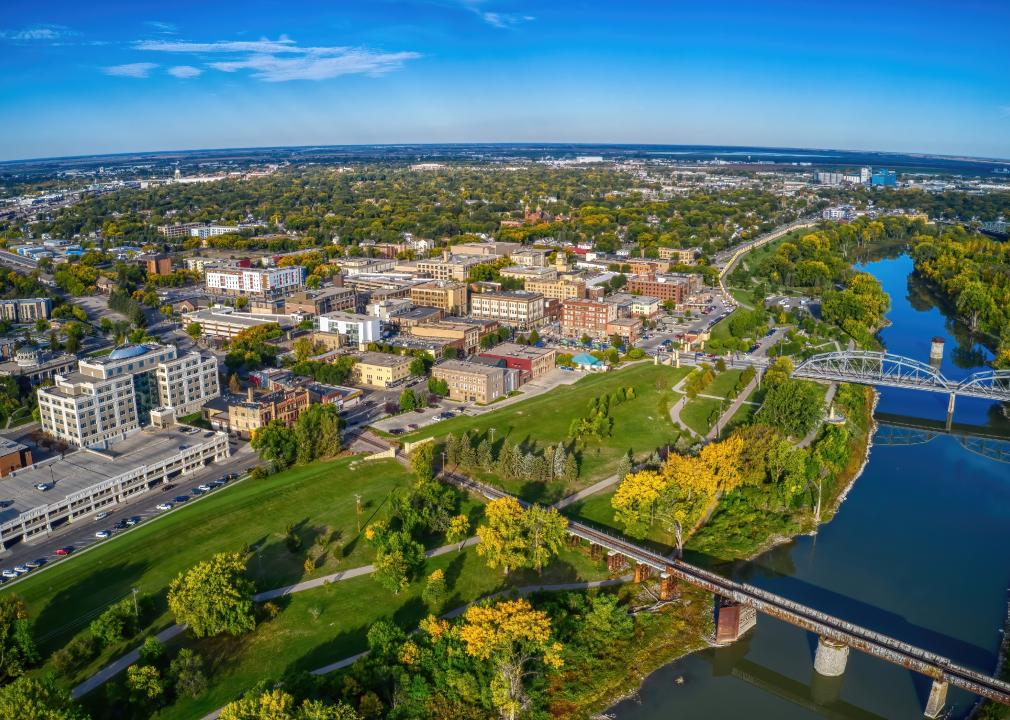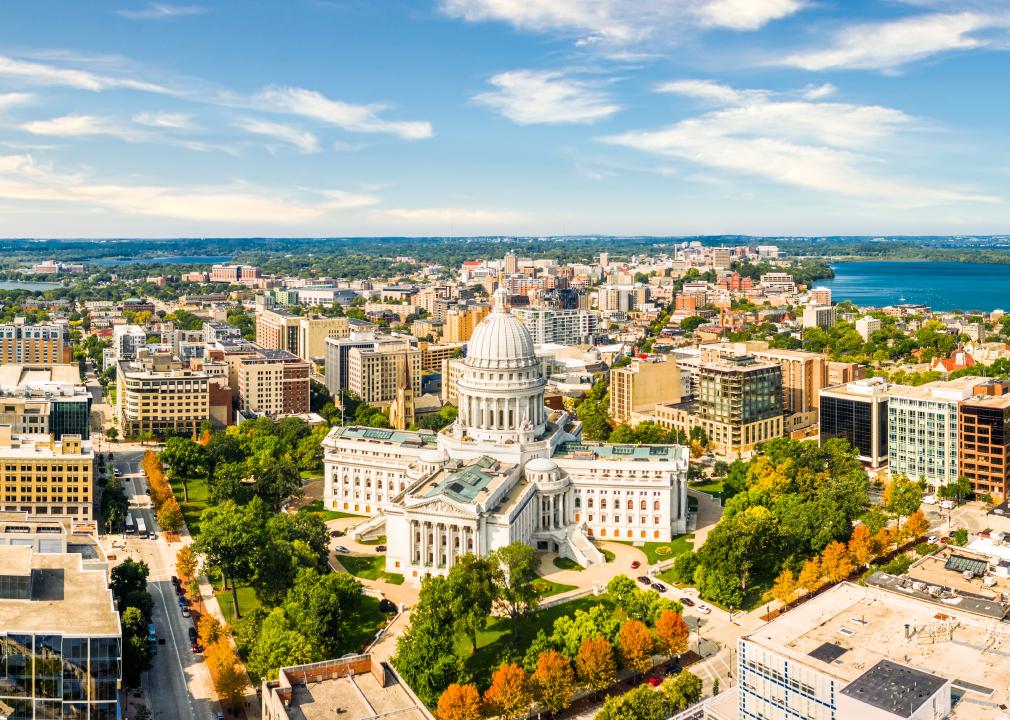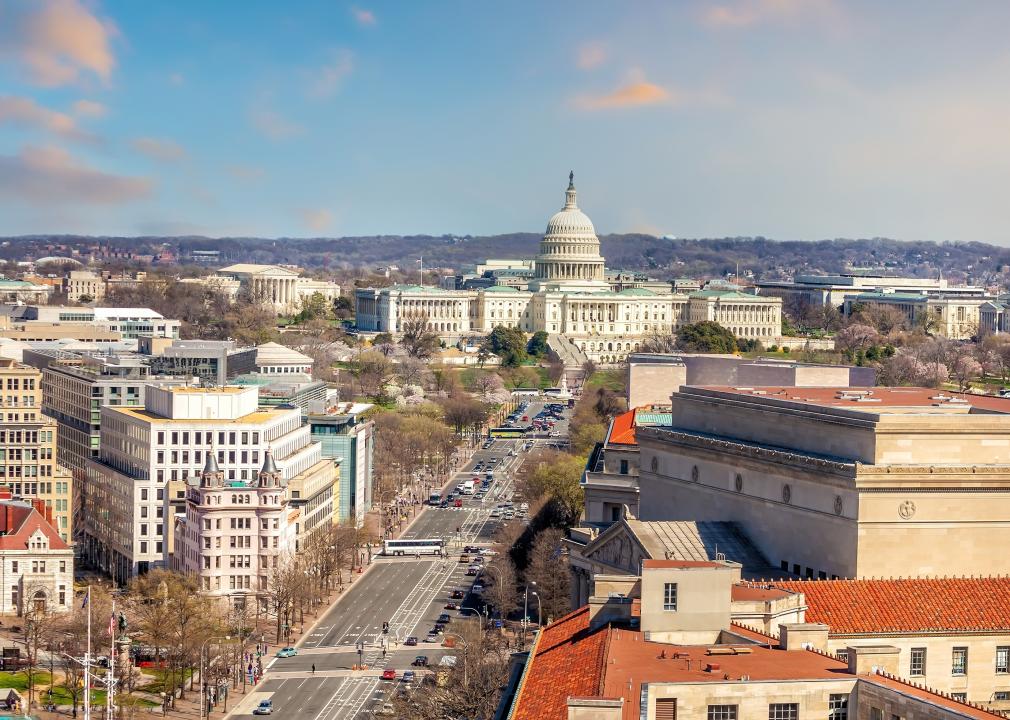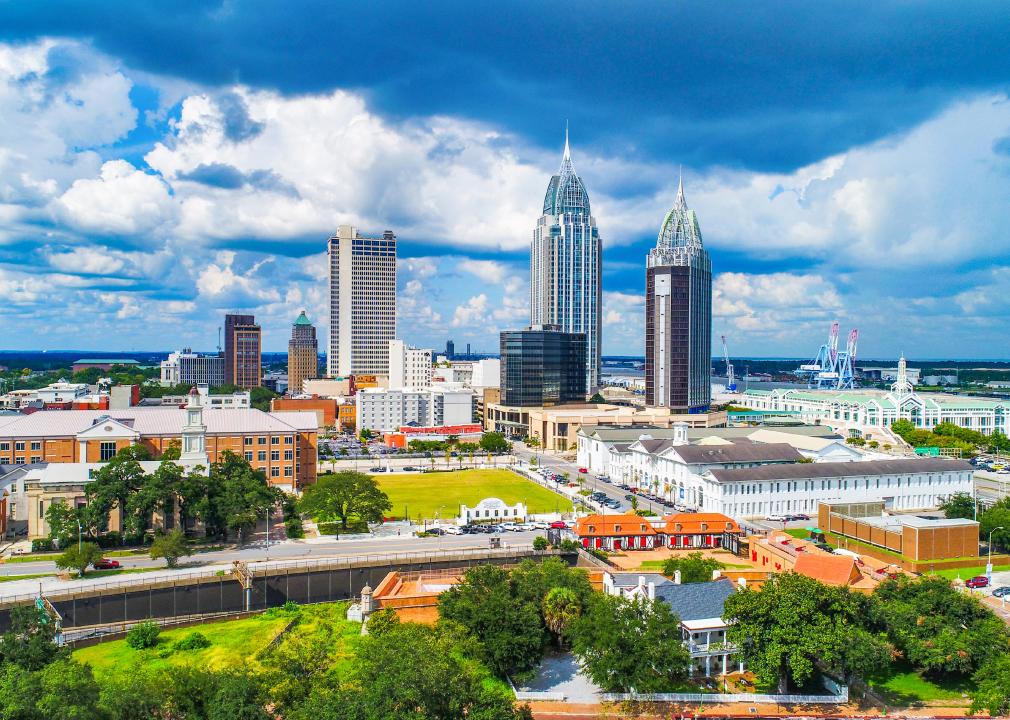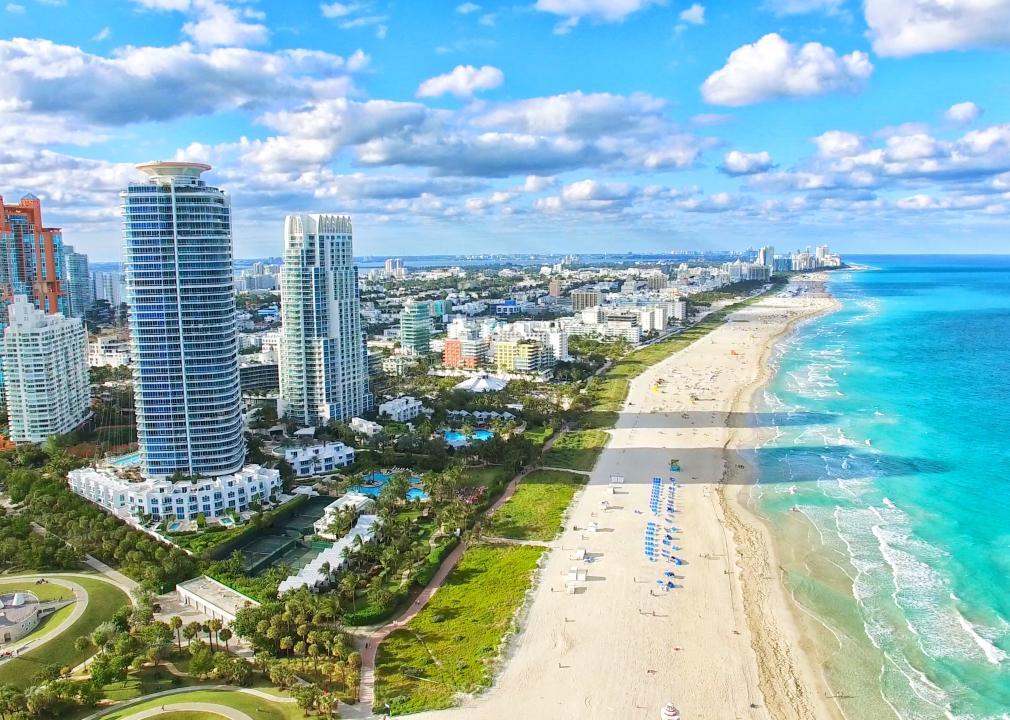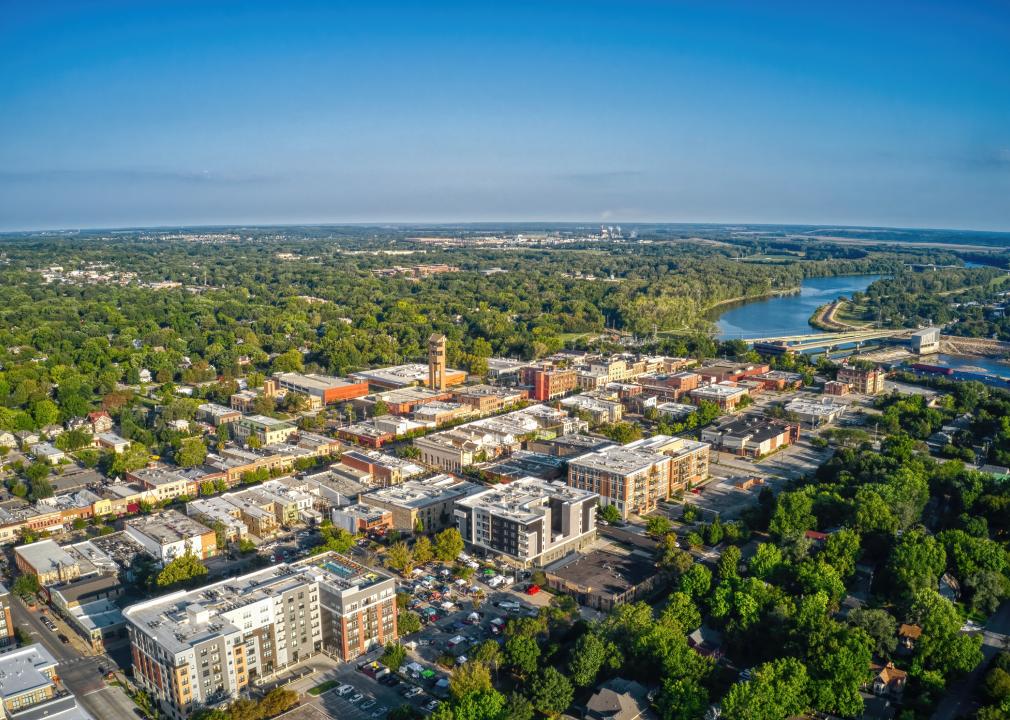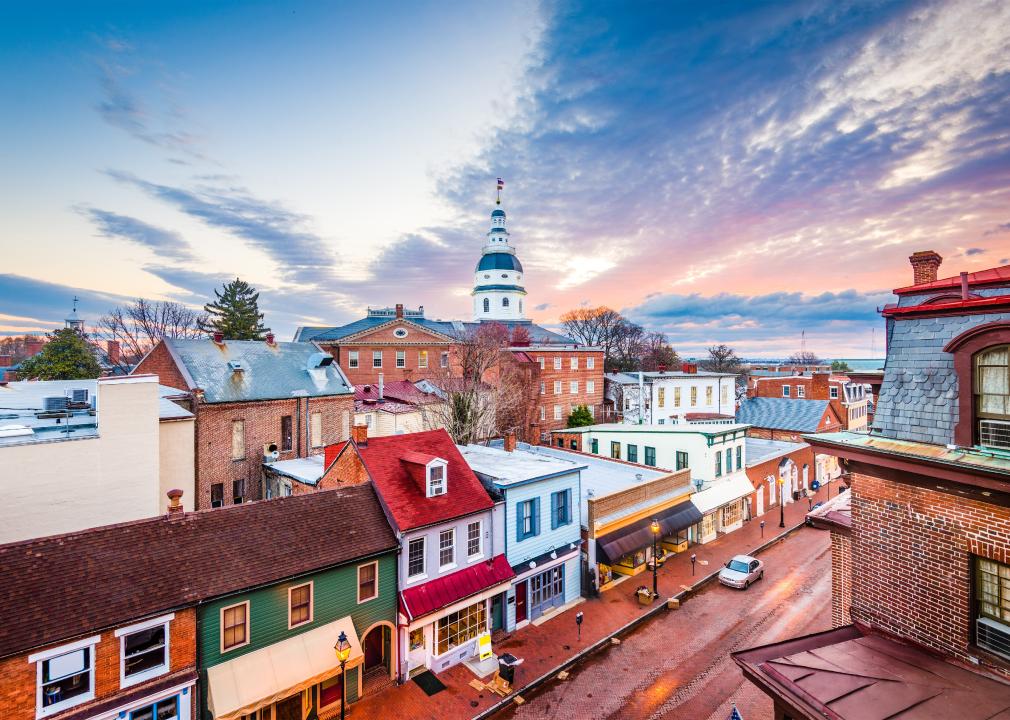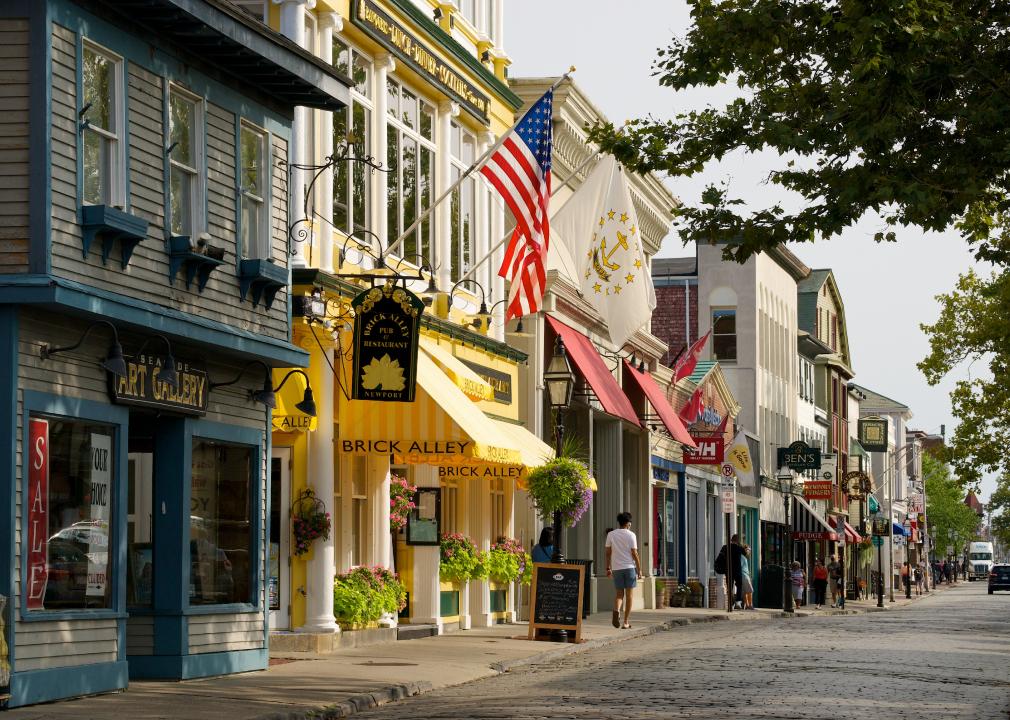States where road conditions are deteriorating fastest
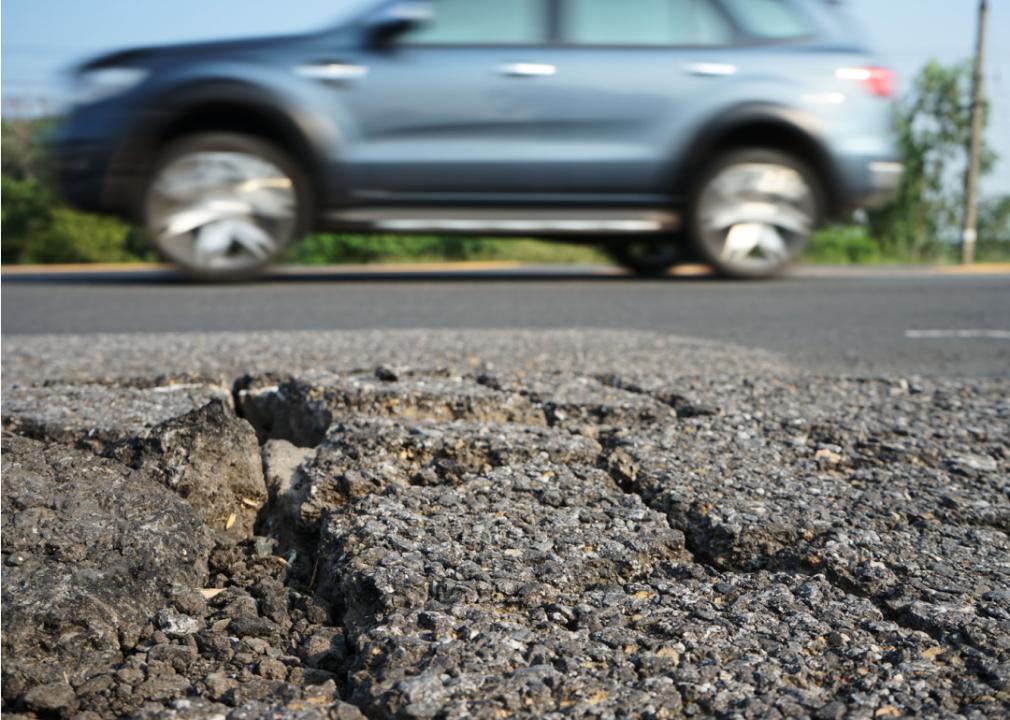
Suwichan // Shutterstock
States where road conditions are deteriorating fastest
Close up on damaged road surface.
The United States boasts an impressive interstate network of 4.2 million miles of roads—but underlying that reputation is a backlog of $786 billion in needed repairs, according to the American Society of Civil Engineers. On average, the society estimates, American motorists spend a collective $130 billion on extra vehicle repairs and fuel costs as a result of driving on poor-quality roads and bridges.
In 2000, 82.6% of U.S. roads were considered acceptable to drive on, according to federal standards, which look at how rough or smooth a road surface is based on how much vibration a car’s suspension has to absorb while driving on it. By 2020, a smaller share—81%—of U.S. roads were rated acceptable.
TruckInfo.net used Bureau of Transportation Statistics data to map and rank U.S. states by the change in the share of roads that were in acceptable condition over the past two decades. Road condition is determined by the International Roughness Index, which measures deviations from pavement surfaces significant enough to affect driving. Roads with IRI values below 170 are considered to be in acceptable condition, while anything above 170 is considered poor condition. Data represents the percentage point change from 2000 to 2020.
![]()
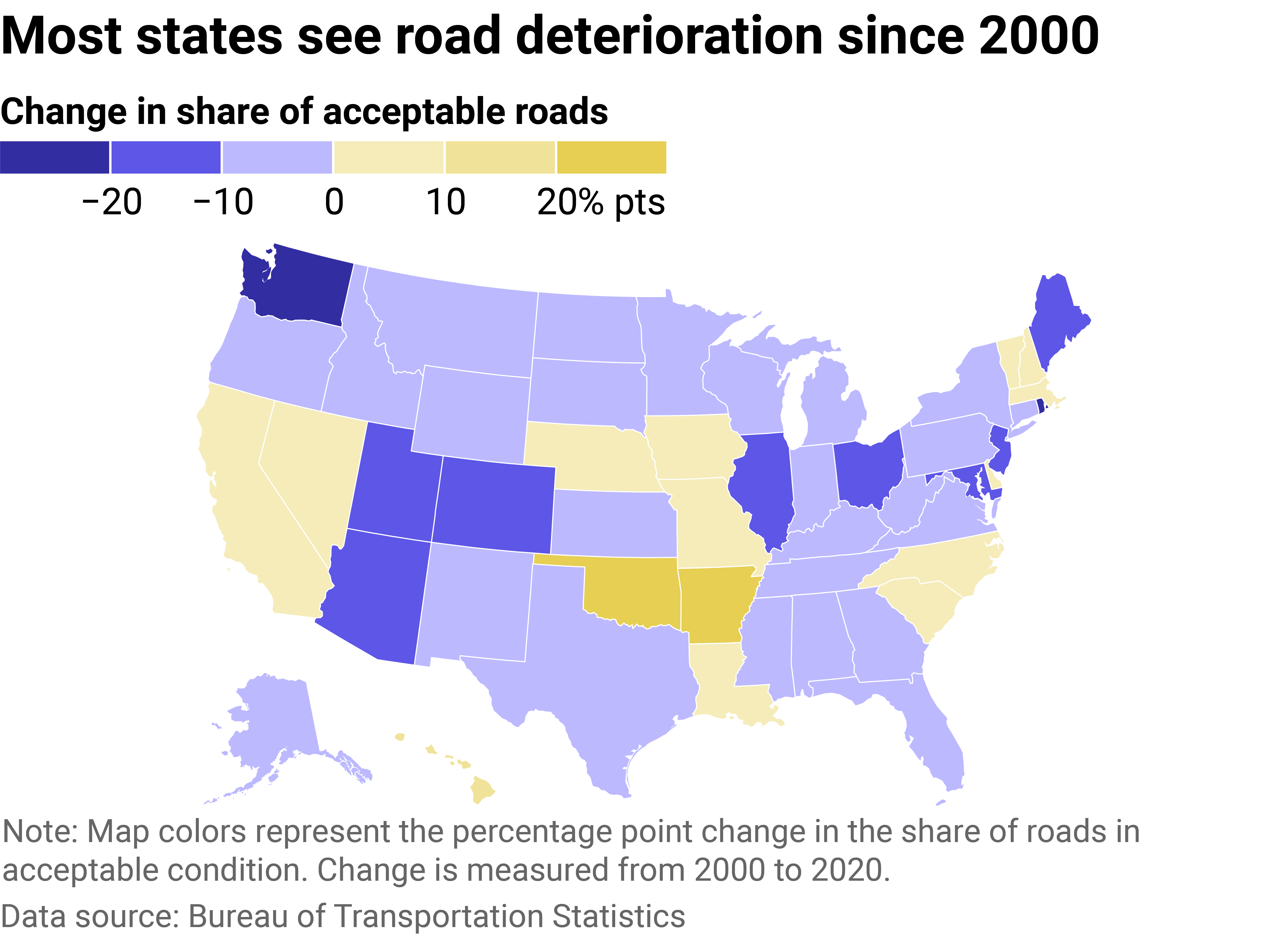
TruckInfo.net
Fewer roads are in acceptable condition in 2020
Map showing the change over time in the share of roads in each state that are considered in acceptable condition.
At first glance, the change in the share of roads in acceptable condition over the past two decades does not appear to be a significant downgrade. However, the nationwide change can be misleading because while some states have improved their road infrastructure, some states have seen a massive decrease in road quality.
States like Rhode Island and Washington have seen over 20% of their roads degrade into poor condition. Other states, including Arkansas and Oklahoma, have conversely seen significant improvements in the quality of their roadways, and are planning to invest more by implementing state-initiated projects and tax hikes. California, which has seen road conditions improve, depends on higher-than-average gas taxes to fund road repair and construction.
Canva
#51. Arkansas
– Share of roads in acceptable condition, 2020: 92.0%
– Change from 2000: +26.8 percentage points
Road conditions have improved the most in Arkansas from 2000 to 2020. Exactly 92% of roads are in acceptable condition, a huge increase from 65.21% in 2000. In 2020, Arkansas voters passed an amendment to the state constitution that mandated a half-cent sales tax to go toward road construction projects, an initiative designed to produce approximately $290 million in revenue each year.
Sean Pavone // Shutterstock
#50. Oklahoma
– Share of roads in acceptable condition, 2020: 93.7%
– Change from 2000: +25.5 percentage points
Oklahoma has had the second-greatest improvement in road conditions of all states. In 2000, 68.2% of roads were in acceptable condition. That percentage has since surged to 93.65% in 2020. The Oklahoma Department of Transportation is currently one year into an eight-year effort to spend $8 billion on highways.
Canva
#49. Hawaii
– Share of roads in acceptable condition, 2020: 60.0%
– Change from 2000: +10.0 percentage points
While only 60% of the roads in Hawaii were in acceptable condition in 2020, the state actually saw a 10 percentage point improvement from 2000. Despite the conditions of roads in the state, Hawaii has the fourth lowest car crash fatality rate in the nation due in part to having the lowest speed limits and less miles of roadway (9,972) compared to other states.
Marek Masik // Shutterstock
#48. California
– Share of roads in acceptable condition, 2020: 67.0%
– Change from 2000: +9.7 percentage points
California roadways have undergone significant improvement in recent decades. In 2000, just 57.35% of roads were in acceptable condition; in 2020, 67% were considered acceptable. This may come as no surprise given the fact that California has the highest gas tax at 77.9 cents per gallon, which goes exclusively toward highway repair and maintenance.
f11photo // Shutterstock
#47. South Carolina
– Share of roads in acceptable condition, 2020: 91.5%
– Change from 2000: +9.1 percentage points
South Carolina has made major strides in road condition improvement since 2000, when 82.41% of roadways were in acceptable condition. In 2020, that number was 91.51%. The state has established “C funds,” which function as a partnership between counties and the state to fund local road and infrastructure projects.

Albert Pego // Shutterstock
#46. Vermont
– Share of roads in acceptable condition, 2020: 80.7%
– Change from 2000: +8.6 percentage points
In 2000, 72.1% of roads in Vermont were in acceptable condition. In 2020, that number hovered just above 80%. The state expects to receive $704.8 million under the Bipartisan Infrastructure Law to invest in roads and related infrastructure projects.
Real Window Creative // Shutterstock
#45. Delaware
– Share of roads in acceptable condition, 2020: 83.7%
– Change from 2000: +6.2 percentage points
Just under 84% of the roads in Delaware are in acceptable condition, an improvement from 77.5% in 2000. The state is due to receive $1.4 billion over the next five years under the Bipartisan Infrastructure Law.

Sean Pavone // Shutterstock
#44. Massachusetts
– Share of roads in acceptable condition, 2020: 72.5%
– Change from 2000: +5.8 percentage points
Only 66.61% of roads were in acceptable condition in 2000 in Massachusetts, a percentage that increased to 72.45% as of 2020. Though that’s still a lot of poor-quality roads, Massachusetts has the fewest fatal car accidents per capita of any state at 4.9 deaths per 100,000 people.
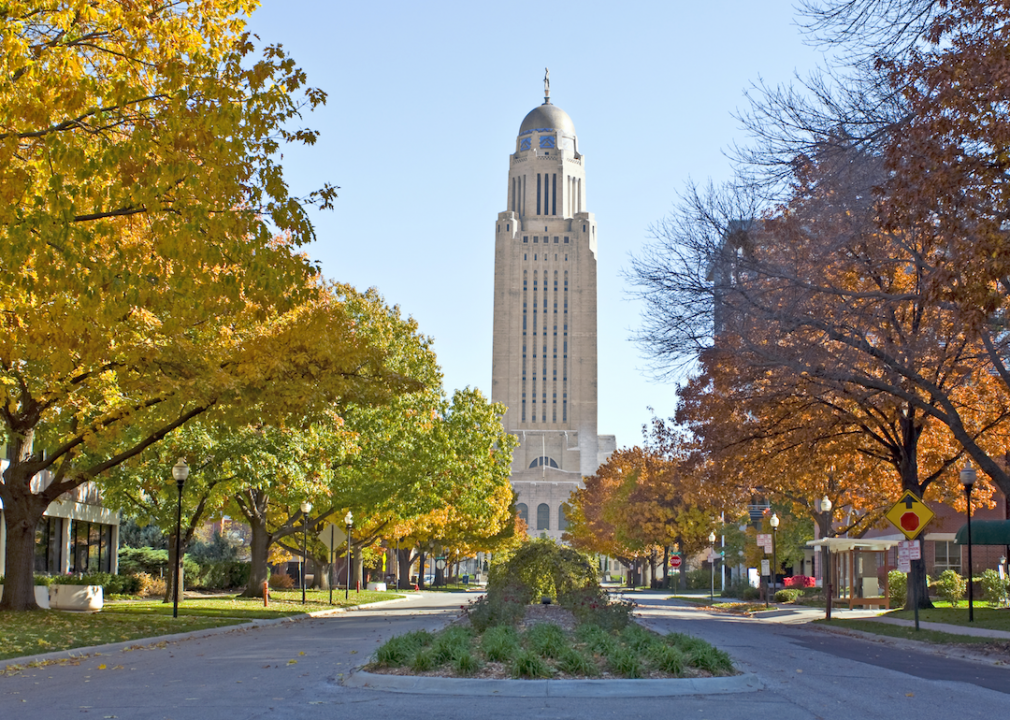
Katherine Welles // Shutterstock
#43. Nebraska
– Share of roads in acceptable condition, 2020: 92.9%
– Change from 2000: +5.7 percentage points
The share of roads in Nebraska in acceptable condition has increased from 87.23% in 2000 to 92.9% in 2020. This improvement may be attributable to the fact that Nebraska spends a larger portion of its annual budget on infrastructure than any other state, according to a U.S. News & World Report analysis of Census Bureau data.
Jacob Boomsma // Shutterstock
#42. Iowa
– Share of roads in acceptable condition, 2020: 91.1%
– Change from 2000: +5.4 percentage points
Iowa has made significant improvements to its road system: Its share of roads in acceptable condition increased from 85.7% in 2000 to 91.09% in 2020. The Hawkeye State is looking to do even better, and spent a record $1.47 billion on improving roads and bridges in 2022, including smoothing pavement and improving road markings.
randy andy // Shutterstock
#41. Nevada
– Share of roads in acceptable condition, 2020: 85.7%
– Change from 2000: +4.2 percentage points
The home of Las Vegas is also home to improving road conditions—in 2000, 81.43% of roads were in acceptable condition. This has increased by over 4 percentage points to 85.66% in 2020. Through the Biden administration’s Bipartisan Infrastructure Law, the state’s highway fund will receive $2.5 billion to support road work.
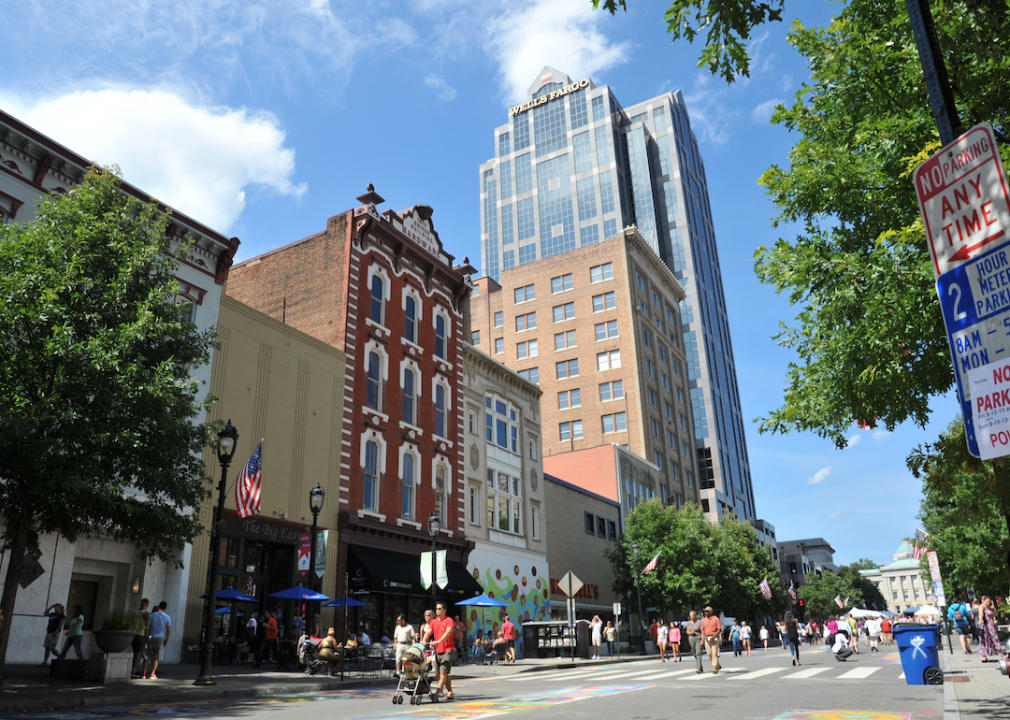
Sharkshock // Shutterstock
#40. North Carolina
– Share of roads in acceptable condition, 2020: 89.5%
– Change from 2000: +3.1 percentage points
The road conditions in North Carolina have improved from 86.46% acceptable in 2000 to 89.51% acceptable in 2020. The state mostly uses its 38.5-cent-per-gallon gas tax to fund road construction, though the state legislature recently also sent $200 million in sales tax revenue to the transportation department for road repair and construction.
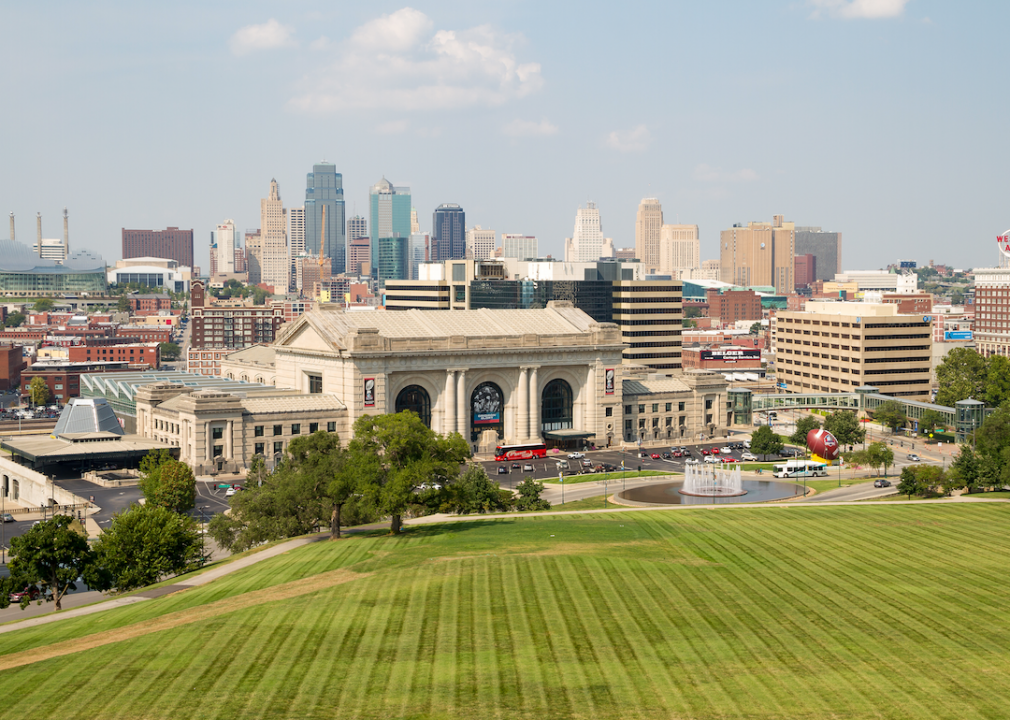
TommyBrison // Shutterstock
#39. Missouri
– Share of roads in acceptable condition, 2020: 75.6%
– Change from 2000: +2.4 percentage points
Missouri roads have also improved slightly in condition since 2000, when 73.2% of roads were considered to be in acceptable condition. That percentage is now 75.64%. However, the state still ranked sixth for people searching Google for information on pothole damage to their cars.
Sean Pavone // Shutterstock
#38. Louisiana
– Share of roads in acceptable condition, 2020: 77.0%
– Change from 2000: +1.1 percentage points
Roadways in Louisiana have improved slightly over the past 20 years. In 2000, just under 76% of roadways were in acceptable condition. Today, just over 77% of roads meet that criterion. In an effort to make further improvements, Louisiana lawmakers recently reallocated 60% of vehicle sales taxes to pay for road maintenance and construction.

Sean Pavone // Shutterstock
#37. New Hampshire
– Share of roads in acceptable condition, 2020: 82.4%
– Change from 2000: +0.1 percentage points
The quality of roads in New Hampshire is roughly the same as it was two decades ago, when 82.32% were in acceptable condition. Now, 82.39% are considered suitable for driving. Under the state’s constitution, any excess revenue related to motor vehicles must be put towards the New Hampshire Highway Fund, used exclusively for the maintenance and repair of highways.
JohnDSmith // Shutterstock
#36. South Dakota
– Share of roads in acceptable condition, 2020: 86.3%
– Change from 2000: -0.5 percentage points
Little has changed in the conditions of roadways in South Dakota since 2000, when 86.76% were in acceptable condition. Today, that percentage is 86.25%. However, half of the state’s bridges are now over 50 years old—the age at which a bridge typically needs significant repairs or replacement.
Sean Pavone // Shutterstock
#35. West Virginia
– Share of roads in acceptable condition, 2020: 68.7%
– Change from 2000: -1.3 percentage points
Road conditions have only slightly degraded in West Virginia over the past 20 years: 69.95% of roads were in acceptable condition in 2000, and 68.65% are as of 2020. The West Virginia Department of Transportation established the Roads to Prosperity program in 2017, aiming to fund approximately $2.8 billion of roadwork in the state over the coming years.
Sean Pavone // Shutterstock
#34. Oregon
– Share of roads in acceptable condition, 2020: 88.6%
– Change from 2000: -1.6 percentage points
Just over 90% of the roads in Oregon were in acceptable condition 20 years ago; now, that share is 88.57%. According to the Oregon Department of Transportation, the state receives about half a billion dollars in road funding each year from the Federal Highway Administration, in addition to state funds raised through sources like the lottery and cigarette taxes.
Kevin Ruck // Shutterstock
#33. Tennessee
– Share of roads in acceptable condition, 2020: 94.6%
– Change from 2000: -1.7 percentage points
About 94.6% of roads in Tennessee are in acceptable condition, down from 96.32% in 2000. The Volunteer State spends a larger share of its total annual budget than all other states except Nebraska.
Canva
#32. Mississippi
– Share of roads in acceptable condition, 2020: 73.9%
– Change from 2000: -1.9 percentage points
Just over three-quarters of roads in Mississippi were in acceptable condition in 2000; now, 73.8% are. The state also has the most fatal car accidents per capita with a rate of 26.2 deaths per 100,000 residents. The Mississippi Department of Transportation recently secured an additional $620 million for state roadwork from the state legislature.
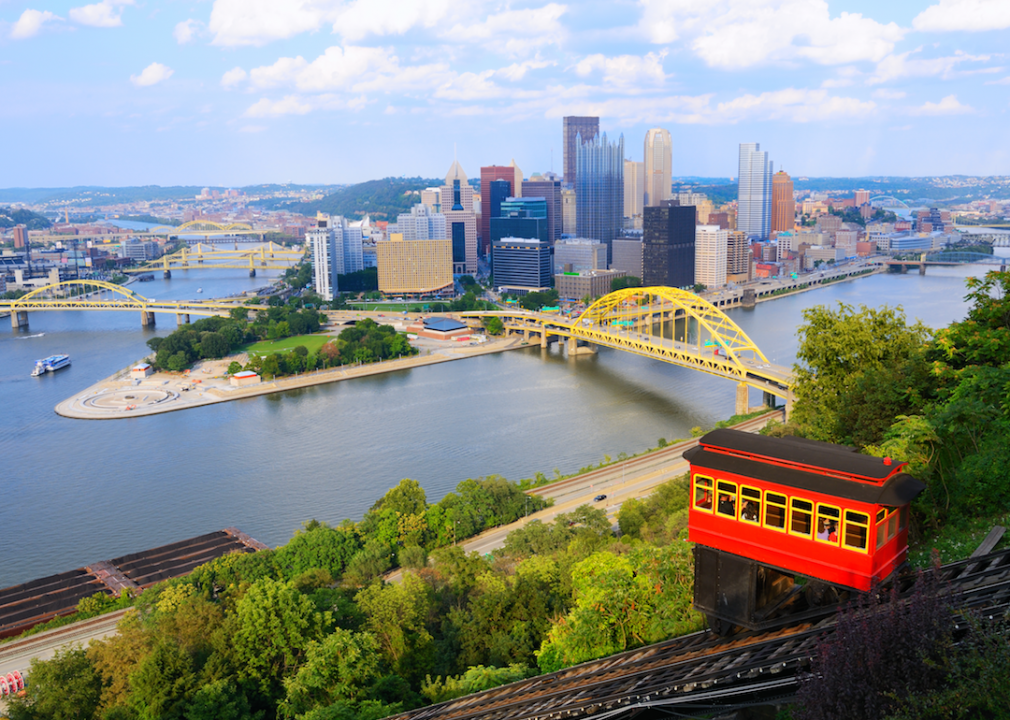
ESB Professional // Shutterstock
#31. Pennsylvania
– Share of roads in acceptable condition, 2020: 72.4%
– Change from 2000: -2.0 percentage points
In 2000, 74.3% of Pennsylvania’s roads were in acceptable condition compared to 72.35% in 2020. This smaller decline compared to other states may be due in part to the state having the third highest gas tax rate in the country, which helps fund roadwork and repair.
Canva
#30. Minnesota
– Share of roads in acceptable condition, 2020: 90.7%
– Change from 2000: -2.2 percentage points
Minnesota drivers enjoy over 90% of roads in acceptable condition, though this is down from 92.84% in 2000. About 70% of the state’s transportation spending is on roadways. That includes money from its gas tax of 28.5 cents per gallon.
Charles Knowles // Shutterstock
#29. Idaho
– Share of roads in acceptable condition, 2020: 90.2%
– Change from 2000: -2.2 percentage points
As of 2020, 90.2% of roads in Idaho are in acceptable condition—a slight downgrade from 92.43% in 2000. The state is set to receive more than $855 million for roads, bridges, safety projects, and more from the Biden administration’s Bipartisan Infrastructure Law.
Rotorhead 30A Productions // Shutterstock
#28. Kentucky
– Share of roads in acceptable condition, 2020: 92.6%
– Change from 2000: -2.3 percentage points
The state has gone from nearly 95% of roads in acceptable condition in 2000 to 92.59% in 2020. The state government expects to receive more than $5 billion over five years for highways and bridges under the Biden administration’s Bipartisan Infrastructure Law.
Sean Pavone // Shutterstock
#27. New Mexico
– Share of roads in acceptable condition, 2020: 66.0%
– Change from 2000: -3.6 percentage points
Just 65.96% of roads in New Mexico are in acceptable condition, down from 69.56% in 2000. This results in an average of an additional $770 in vehicle maintenance and fuel costs for residents, according to TRIP. Like many states, its road repair funds depend in part on gas taxes, which are the third lowest in the nation. The state legislature has debated both increasing and eliminating it in recent years.
Sean Pavone // Shutterstock
#26. Indiana
– Share of roads in acceptable condition, 2020: 81.8%
– Change from 2000: -3.7 percentage points
Roadway conditions have gotten slightly worse over two decades in Indiana. About 82% of roads are in good condition as of 2020, down from 85.42% in 2000. In 2017, the state legislature passed a plan to boost spending on local roads by $342 million annually.
LBill45 // Shutterstock
#25. Wyoming
– Share of roads in acceptable condition, 2020: 94.3%
– Change from 2000: -4.4 percentage points
Wyoming’s roadways have deteriorated only slightly over the past 20 years. In 2000, 98.71% of roads were in acceptable condition; in 2020, that number dropped to 94.27%. Despite having relatively well-kept roads, Wyoming has the second-highest number of fatal car accidents per capita with a death rate of 22 deaths per 100,000 people, according to an analysis of federal data.
Canva
#24. Alaska
– Share of roads in acceptable condition, 2020: 80.9%
– Change from 2000: -4.6 percentage points
Just over 80% of roadways in Alaska are in acceptable condition, down from 85.46% at the turn of the century. Driving on deteriorated roads costs each Alaskan motorist $441 a year, according to the TRIP. The organization also estimates that poor road conditions contribute to approximately one out of every three fatal vehicle crashes in the state.
Jacob Boomsma // Shutterstock
#23. North Dakota
– Share of roads in acceptable condition, 2020: 94.1%
– Change from 2000: -4.8 percentage points
North Dakota once had close to 99% of its roads in acceptable condition, but now that percentage has dropped to 94.13%. According to the North Dakota Department of Transportation, the state spends an estimated $180,000 to $265,000 per mile in preventive maintenance costs to maintain the state highway system’s 8,600 miles of road. And that doesn’t include the other 80,000 miles of road in the state.
Sean Pavone // Shutterstock
#22. Michigan
– Share of roads in acceptable condition, 2020: 78.6%
– Change from 2000: -5.2 percentage points
Just under 84% of roads in Michigan were in acceptable condition in 2000, a share that dropped to 78.61% in 2020. The state is currently pursuing multiple road and pavement repair projects across the state, bringing the total miles of road repaired to nearly 20,000 since 2019.
Sean Pavone // Shutterstock
#21. Texas
– Share of roads in acceptable condition, 2020: 77.6%
– Change from 2000: -5.4 percentage points
Roads in the Lone Star State have deteriorated in the past 20 years—in 2000, just under 83% of roads were in acceptable condition while 77.6% were in 2020. In response to unsafe driving and incidents stemming from roads in poor conditions, the Texas legislature passed House Bill 1885 in June, which permits local authorities to temporarily change the speed limit on roads during inclement weather, construction, or because the road itself is in bad shape.
Sean Pavone // Shutterstock
#20. Virginia
– Share of roads in acceptable condition, 2020: 86.8%
– Change from 2000: -6.1 percentage points
Nearly 93% of roads in Virginia were in acceptable driving condition in 2000; now, 86.78% are. However, the state ranked first in the nation for the cost-effectiveness and condition of its highway system according to the Reason Foundation’s 2023 Annual Highway Report.
Canva
#19. Georgia
– Share of roads in acceptable condition, 2020: 92.8%
– Change from 2000: -7.0 percentage points
Georgia had one of the highest rates of roads in acceptable condition in 2000 at 99.86%. Twenty years later, that has dropped to just under 93%. According to TRIP, Georgia motorists each spend an average of $410 per year on vehicle maintenance costs and fuel consumption as a result of driving on poorly maintained Georgia roads.
Mihai_Andritoiu // Shutterstock
#18. Wisconsin
– Share of roads in acceptable condition, 2020: 74.8%
– Change from 2000: -7.9 percentage points
About three out of every four road miles in Wisconsin are in acceptable condition, compared to 82.65% in 2020. Under the Biden administration’s Bipartisan Infrastructure Law, the state will receive $2.4 billion in support of the repair and maintenance of roads, public transit, bridges, and more.
f11photo // Shutterstock
#17. District of Columbia
– Share of roads in acceptable condition, 2020: 8.6%
– Change from 2000: -8.3 percentage points
The nation’s capital has some of the least acceptable driving conditions in the country. In 2000, just 16.95% of roads were in acceptable condition; now, less than 9% are. The District Department of Transportation aims to eliminate all roads in poor condition by 2024 under the PaveDC program.
Kevin Ruck // Shutterstock
#16. Alabama
– Share of roads in acceptable condition, 2020: 90.9%
– Change from 2000: -8.6 percentage points
Most roads in Alabama are in acceptable condition at 90.86%, but that percentage was just under 100% 20 years ago. Still, the state has the second-smoothest roads in America according to a MoneyGeek analysis of federal data. Under the Biden administration’s Bipartisan Infrastructure Law, Alabama expects to receive $5.8 billion over five years for highway and bridge repair.
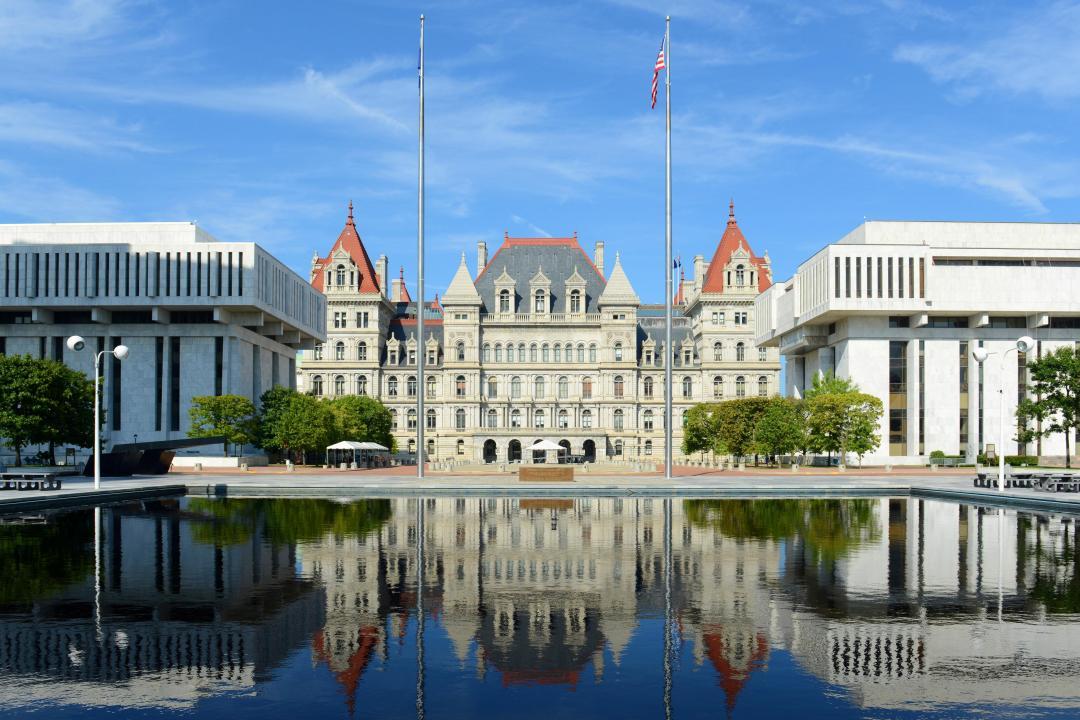
Wangkun Jia // Shutterstock
#15. New York
– Share of roads in acceptable condition, 2020: 74.0%
– Change from 2000: -8.9 percentage points
Just under 83% of New York roads were in acceptable condition in 2000, but that percentage has since dropped to 73.97%. Luckily for residents, New York also operates the largest public transportation system on the continent. The state spends approximately $15 billion each year on transportation costs, including road repair and maintenance.
Sean Pavone // Shutterstock
#14. Connecticut
– Share of roads in acceptable condition, 2020: 67.0%
– Change from 2000: -9.5 percentage points
Just 21% of the roads in Connecticut are considered to be in good condition. Meanwhile, just 67.02% are in acceptable condition—a downgrade from 76.55% 20 years ago. Under the Biden administration’s infrastructure plan, Connecticut expects to receive $1.6 billion to support the repair and maintenance of roads and bridges.
Mihai_Andritoiu // Shutterstock
#13. Montana
– Share of roads in acceptable condition, 2020: 87.3%
– Change from 2000: -9.6 percentage points
The share of roads in acceptable driving condition in Montana dropped from 96.88% to 87.31% from 2000 to 2020. The state is on the tail end of a six-year progressive motor fuel tax increase, the Bridge and Road Safety and Accountability Act of 2017, which aimed to supplement funding for transportation initiatives in the state.
Mia2you // Shutterstock
#12. Florida
– Share of roads in acceptable condition, 2020: 87.7%
– Change from 2000: -9.7 percentage points
Twenty years ago, 97.36% of roads in Florida were in acceptable condition. Today, that percentage is 87.66%. Despite these stats, the state ranked 8th in the Reason Foundation’s Annual Highway Report due to its cost-effectiveness.
Jacob Boomsma // Shutterstock
#11. Kansas
– Share of roads in acceptable condition, 2020: 88.6%
– Change from 2000: -10.0 percentage points
Over 98% of roads in Kansas were in acceptable condition 20 years ago, but that percentage has since dropped to 88.57%. Driving on roads in unacceptable conditions costs Kansas residents a per-driver average of $532 per year, according to TRIP.
Sean Pavone // Shutterstock
#10. Illinois
– Share of roads in acceptable condition, 2020: 80.2%
– Change from 2000: -10.5 percentage points
In 2000, over 90% of the roads in Illinois were rated as being in acceptable condition. By 2020, that share had dropped by about 10 percentage points. Illinois spends $123,522 per state-controlled mile of highway, ranking 39th nationally for total disbursements per mile.
Mihai_Andritoiu // Shutterstock
#9. New Jersey
– Share of roads in acceptable condition, 2020: 55.2%
– Change from 2000: -11.2 percentage points
Current-day New Jersey has one of the lowest percentages of roads in acceptable condition at 55.16%, though it was 66.34% in 2000. The Reason Foundation’s 2021 Annual Highway Report, which ranks the states according to the condition and cost-effectiveness of state-controlled highways, ranked New Jersey last for overall highway performance.

Joseph Sohm // Shutterstock
#8. Maine
– Share of roads in acceptable condition, 2020: 79.3%
– Change from 2000: -11.8 percentage points
The roads in Maine withstand around 15 billion miles of vehicle travel per year. In 2000, 91% of roadways in the state were in acceptable condition, but in 2020 that dropped to 79.29%. A 2021 report by TRIP estimated that the condition of roads in Maine costs drivers $1.3 billion per year in wasted fuel, lost time, and additional car maintenance.
Canva
#7. Ohio
– Share of roads in acceptable condition, 2020: 83.7%
– Change from 2000: -12.4 percentage points
Ohio once boasted over 96% of roads in acceptable condition, but that amount has since dropped to 83.69% as of 2020. Cleveland was also ranked sixth among U.S. cities for worst maintained roads, resulting in an estimated average of $887 extra in vehicle maintenance costs for Cleveland-based drivers.

Canva
#6. Colorado
– Share of roads in acceptable condition, 2020: 78.1%
– Change from 2000: -12.5 percentage points
Over 90% of Colorado roads were in acceptable condition 20 years ago, but today that percentage is 78.12%. The state’s Department of Transportation cites challenges in receiving sufficient funding—30 years ago, the state spent an average of $125 per person on transportation. Today, that amount has dropped to about $81 per person.
Sean Pavone // Shutterstock
#5. Utah
– Share of roads in acceptable condition, 2020: 80.0%
– Change from 2000: -13.9 percentage points
While 93.81% of roads were in acceptable condition in 2000, just under 80% remain so today in the state of Utah. On the other hand, the state ranked best in the nation for the condition of its highway bridges in a 2022 assessment by the Federal Highway Administration.
Sean Pavone // Shutterstock
#4. Maryland
– Share of roads in acceptable condition, 2020: 72.3%
– Change from 2000: -16.5 percentage points
When it comes to the roadways in Maryland, 72.28% are in good condition—down from 88.76% in 2000. The state also ranked second in urban interstate highway traffic congestion in a 2021 TRIP report showing 83% of its urban interstates were as congested.
Sean Pavone // Shutterstock
#3. Arizona
– Share of roads in acceptable condition, 2020: 77.5%
– Change from 2000: -19.9 percentage points
The percentage of roads in Arizona in good condition has dropped from 97.33% to 77.46% over the course of 20 years. As of November 2022, approximately 132 bridges and more than 3,193 highway miles in Arizona were in poor condition. The state is set to receive about $5.3 billion from the Bipartisan Infrastructure Law for highway and bridge projects.
Agnieszka Gaul // Shutterstock
#2. Washington
– Share of roads in acceptable condition, 2020: 71.5%
– Change from 2000: -26.5 percentage points
In 2000, just over 98% of roads in Washington were in good condition. Twenty years later, that percentage dropped to 71.53%. Under the Biden administration’s infrastructure law, Washington state is expected to receive $5.3 billion in total by 2027 to support the repair and improvement of the state’s roads and bridges.
George Wirt // Shutterstock
#1. Rhode Island
– Share of roads in acceptable condition, 2020: 51.9%
– Change from 2000: -33.3 percentage points
The percentage of roads in acceptable condition dropped from 85.18% in 2000 to just 51.93% in 2020. This makes Rhode Island the state with the worst road conditions in the nation. The state’s Department of Transportation is currently seven years into fulfilling a 10-year plan to improve infrastructure, which includes road repair.
Data reporting by Paxtyn Merten. Story editing by Jeff Inglis. Copy editing by Tim Bruns.
This story originally appeared on TruckInfo.net and was produced and
distributed in partnership with Stacker Studio.
